
There are times, sometimes a whole day or week, or maybe just moments in the day, when life feels like it is waving in our faces a large, hairy clenched fist of NO! or WAIT!: unable, or perhaps unwilling to meet our needs and wants. Our need for affection, reciprocity, self-expression, freedom to play and be creative. Our wanting to have an email answered asap, or for it to stop raining, or for a family member to show interest in us.
Whatever form this deprivation takes, however small or large, it doesn’t feel good. It’s also not uncommon for the clenched fist of NO! to move from the source of deprivation (the resistant, unyielding environment) to our inner-world, feeling like heartburn or haemorrhoids punitive in nature, as if we really are being fisted by someone or something. We might develop a masochistic taste for this experience, but on the whole we are averse to pain, seekers of pleasure, to hands that are open, welcoming, willing and wanting to clasp ours in theirs, leading the way, guiding us, accompanying us on our journey.
This winter of the soul takes on an anthropomorphic resonance as we head towards the dormant season as gardeners. Even though the icy frosts have yet to come, so much in the garden is already dragging, drooping, dying. The tomato bushes still have dots of colour to them, but it is a rancid, inedible red. The late-blooming Michaelmas Daisies of mid-October are now shrivelled, wasted, mortified.
Where does one look for abundance and plenitude when all we can see or feel is insufficiency and want?
One way is to actively seek out those places in the garden or our lives where there is prosperity, or at least comfortable adequacy. Turning purposefully away from the clenched fist of denial or refutation, not in an angry or dismissive way, but rather as if we might turn from a Henry Moore statue we’re no longer getting any pleasure from looking at, towards another piece in the sculpture park that might offer something we need or want. Or to a tree. Or a handful of seeds. Literally and metaphorically.
This is what I’ve been trying to do this week, working from the premise that next to, or under the clenched fist of withholding, of nix, there is always some kind of indulgence and gratification to be found. Maybe I’ve just got to get on my hands and knees and scrabble about in the dirt a while to find it.
Behold a pink chard plant grown wild and tangly from last summer, having developed a profuse, Medusa-like pink afro, now ready to harvest for its seeds. Hundreds of corky nubs which next year, and for many a year after that, will give me pink patches of good-to-look-at, good-to-eat loveliness.
Behold, from the withered husks of my Cosse Violette and Neckargold bean plants, two Amazon book-package loads of bean seeds. Jack, as we know, gave away the beloved family cow, Milky White, for far less. Seeds to plant, or put in soups. Seeds that feel cool and silky-smooth to hold, pleasurable and sensual objects in and of themselves.
Bruno Bettelheim in his psychoanalytic reading of this fairy tale sees Jack and The Beanstalk as a fable about how we might overcome our developmental oral stage, which is to say our utmost dependency on our caretaker’s breast/teat/hand, wrenching ourselves away from the comfort and safety that the source of this nourishment supplies. Compare the utter despair when Milky White stops giving us milk, the non-lactating breast or teat, to the clenched fist of NO or WAIT.
“Given all the dangers of regressing to orality”, writers Bettelheim, “here is another implied message of the Jack story: it was not at all bad that Milky White stopped giving milk. Had this not happened, Jack would not have gotten the seeds out of which the beanstalk grew. Orality thus not only sustains—when hung on to too long, it prevents further development; it even destroys, as does the orally fixated ogre.”
So how not to turn into orally fixated ogres ourselves?
The answer may lie in an old-fashioned virtue, which now in the updated language of positive psychology would be referred to as a “character strength”. The virtue/character strength is Gratitude. Recent research (Park et al., 2004) has shown that having a strongly developed sense of gratitude (alongside Hope, Zest, Love, and Curiosity – although gratitude alone works just fine too) is “substantially related to life satisfaction”.
Interestingly, in this same survey looking at the relationship between character strengths and life satisfaction among 5,299 adults, other virtues such as modesty and intellectual competencies (appreciation of beauty, creativity, judgement, and love of learning) were much more weakly associated with feeling good about ourselves and our lives.
This makes a lot of sense to me. My top character strengths (you can do a 15 minute survey here to find out yours) are love of learning, creativity, appreciation of beauty and excellence, perspective, curiosity, love and judgement.
Gratitude is number 19 out of 24 for me on this list (teamwork is number 24). Might gratitude better inoculate me/us against the clenched fist of NO? Was old Cicero right when he wrote more than 2000 years ago that “gratitude is not only the greatest of virtues, but a parent of all the others”?
The difficulty we face when turning up the dial on gratitude in our lives, notes Robert Emmons in a chapter entitled ‘Gratitude in Trying Times’, is that often when one part of us most need the benefits of this character strength, another part feels itself especially unwilling to apply it:
“It is relatively easy to feel grateful when good things are happening, and life is going the way we want it to. A much greater challenge is to be grateful when things are not going so well, and are not going the way we think they should. Anger, bitterness, and resentment seem to be so much easier, so much more a natural reaction in times like these.”
An important distinction might perhaps be made between having the faith to take the medicine we need and doing so, as opposed to feeling in the mood to do it.
As David Steindl-Reist writes: “”times that challenge us physically, emotionally, and spiritually may make it almost impossible for us to feel grateful. Yet, we can decide to live gratefully, courageously open to life in all its fullness. By living the gratefulness we don’t feel, we begin to feel the gratefulness we live.”
So if you’re up for trying to live the gratefulness you don’t feel in the hope that by doing so we’ll begin to feel the gratefulness we live, here’s Emmon’s 10 point plan for doing so.
And my version of this with a garden focus:
1) Keep a plan of everything you’ve got growing in the garden, and regularly reflect on the richness and variety of your plants, providing colour and interest every time you step out of your back door.
2) Remember the bad and harness the power of counterfactuals (things that haven’t happened, but could under differing circumstances): when it’s not raining or when you notice something lovely in the garden that you hadn’t seen before, call to mind the likelihood that it could equally be the other way round, appreciate that it isn’t!
3) Ask yourself 2 questions: What have I received from the garden today? What have I done for it?
4) Learn or write your own poem/prayer to the garden. Sing or recite it inside your garden and away from it. In the depths of winter, bring to mind the joys of spring and summer by whispering to yourself the poem below and luxuriating in the memories of summer days past, and those to come.
Today
If ever there were a spring day so perfect,
so uplifted by a warm intermittent breeze
that it made you want to throw
open all the windows in the house
and unlatch the door to the canary’s cage,
indeed, rip the little door from its jamb,
a day when the cool brick paths
and the garden bursting with peonies
seemed so etched in sunlight
that you felt like taking
a hammer to the glass paperweight
on the living room end table,
releasing the inhabitants
from their snow-covered cottage
so they could walk out,
holding hands and squinting
into this larger dome of blue and white,
well, today is just that kind of day.
-Billy Collins

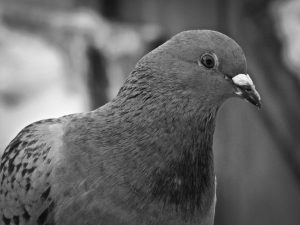 For it is, primarily that (a place of refuge), and not just for me.
For it is, primarily that (a place of refuge), and not just for me. The shadow-side of patience is procrastination. A form of forestalment, with all the discomfort of inertia, torpidity, but none of the dopamine-fuelled incentivizers. As Hesiod, one of the earliest writers on the subject gravely remarks: “a man who puts off work is always at hand-grips with ruin”. Yes, sometimes, it really does feel like that.
The shadow-side of patience is procrastination. A form of forestalment, with all the discomfort of inertia, torpidity, but none of the dopamine-fuelled incentivizers. As Hesiod, one of the earliest writers on the subject gravely remarks: “a man who puts off work is always at hand-grips with ruin”. Yes, sometimes, it really does feel like that. All things come to he who waits, is not entirely true. Even the Victorian poet Violet Fane who coined the phrase feels the need to qualify it in the next line of her poem:
All things come to he who waits, is not entirely true. Even the Victorian poet Violet Fane who coined the phrase feels the need to qualify it in the next line of her poem: Why did I ever doubt I’d get flowers from Jenny?
Why did I ever doubt I’d get flowers from Jenny?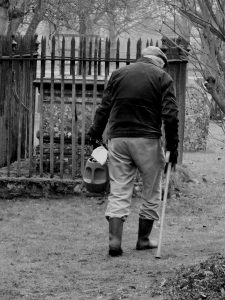 If you don’t water your plants carefully and consistently, especially those not embedded in earth, but exiled in pots and planters, they’ll soon let you know, becoming pallid, etiolated husks of their former selves. Take this poor wilty tomatillo plant on the left that greeted me a few mornings back: not a happy camper.
If you don’t water your plants carefully and consistently, especially those not embedded in earth, but exiled in pots and planters, they’ll soon let you know, becoming pallid, etiolated husks of their former selves. Take this poor wilty tomatillo plant on the left that greeted me a few mornings back: not a happy camper.
 If you’re a Gardener’s World fan, you probably tune in as much to see what a Golden Retriever called Nigel is up to at Longmeadow (mostly activities involving tennis balls) as what his owner Monty Don might be planting that week.
If you’re a Gardener’s World fan, you probably tune in as much to see what a Golden Retriever called Nigel is up to at Longmeadow (mostly activities involving tennis balls) as what his owner Monty Don might be planting that week.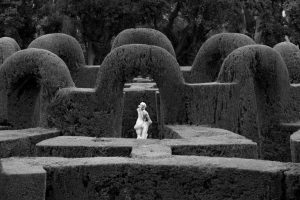 The
The 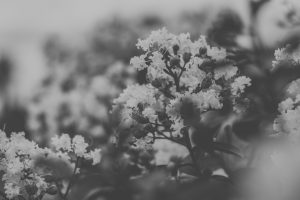 It’s about ten to ten in the evening and I’m standing in semi-darkness beating out the rhythm to
It’s about ten to ten in the evening and I’m standing in semi-darkness beating out the rhythm to 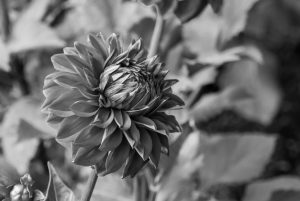 Gardeners take a lot of pride in their gardens. Especially in those plants we’ve grown from seed or a cutting. It’s a parental pride, a feeling of having been there at the moment when the thing before you was an almost-nothing, a blink-and-you’ll-miss-it seed. It’s a pride also borne out of constant fussing and nurturing of our seedling as they matured from vulnerable almost-somethings to very needy small plants almost indistinguishable from the weeds around them, to finally the pleasures of foliage, buds and Bloomsday (not to be confused, though sometimes coinciding with that other
Gardeners take a lot of pride in their gardens. Especially in those plants we’ve grown from seed or a cutting. It’s a parental pride, a feeling of having been there at the moment when the thing before you was an almost-nothing, a blink-and-you’ll-miss-it seed. It’s a pride also borne out of constant fussing and nurturing of our seedling as they matured from vulnerable almost-somethings to very needy small plants almost indistinguishable from the weeds around them, to finally the pleasures of foliage, buds and Bloomsday (not to be confused, though sometimes coinciding with that other  Every day, the hundreds of fronds that make up the lettuce in my raised beds launch into a Lactuca Sativa version of that 80s stadium anthem by Simple Minds:
Every day, the hundreds of fronds that make up the lettuce in my raised beds launch into a Lactuca Sativa version of that 80s stadium anthem by Simple Minds: Having done a bit of a U-turn recently on the Cottage Garden ethos of ornamentals and edibles cheek by jowl, I’ve been clearing some sunny 3ft x 5 ft beds in the front garden with the express purpose of filling them with plants that’ll give me dizzying, eye-popping, heart-pumping highs.
Having done a bit of a U-turn recently on the Cottage Garden ethos of ornamentals and edibles cheek by jowl, I’ve been clearing some sunny 3ft x 5 ft beds in the front garden with the express purpose of filling them with plants that’ll give me dizzying, eye-popping, heart-pumping highs.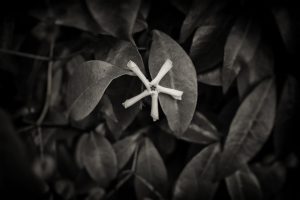 A few months ago I planted some Jasmine beesianum (I’ll call her Jasbee for short) near one of the the wooden trellises with the hope of having her “delicate pink trumpets and a heavenly scent” (oh the come-hither descriptions of plant packaging blurb!) complement the deep purple of summer delphiniums,
A few months ago I planted some Jasmine beesianum (I’ll call her Jasbee for short) near one of the the wooden trellises with the hope of having her “delicate pink trumpets and a heavenly scent” (oh the come-hither descriptions of plant packaging blurb!) complement the deep purple of summer delphiniums,  Yesterday, I woke up, looking forward, with possibly more ardour than anything else in my day to come, to digging a hole.
Yesterday, I woke up, looking forward, with possibly more ardour than anything else in my day to come, to digging a hole.